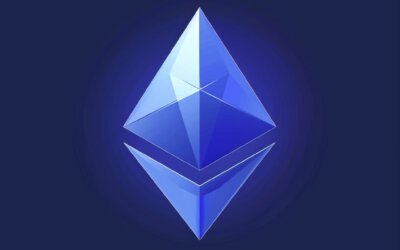Is Cardano Better Than Ethereum? How They Compare

Key Takeaways:
- Cardano and Ethereum share many similarities, including transactional coins, layer 1 blockchain technologies for dApps and smart contracts, and proof-of-stake consensus mechanisms.
- However, there are major differences between the two, such as Ethereum being more established, having higher transaction volumes, overall supply, and scalability.
- Advantages of Cardano include strong backing, lower costs and energy usage, and better potential for scaling, while its disadvantages include having many competitors, an unfinished product, and less demand.
- Ethereum boasts a first mover advantage, a large ecosystem, and high liquidity, making it a popular choice among investors and developers.
Key Similarities between Cardano and Ethereum
As I delve deeper into the world of cryptocurrency, I find myself struck by the similarities between Cardano and Ethereum. On closer inspection, I discovered that the two blockchain giants share more similarities than differences. In this section, I’ll take a closer look at what I found. Firstly, there are the transactional coins – ADA and ETH. Then, there are the Layer 1 blockchain technologies for dApps and smart contracts, which are integral to both ecosystems. Lastly, I’ll explore the proof-of-stake consensus mechanisms and how they underpin the security of both Cardano and Ethereum networks.
Transactional coins
Both Cardano and Ethereum serve as transactional coins, with ADA and ETH being their respective coins. They both facilitate financial transactions on their respective platforms. Additionally, they employ Layer 1 blockchain technologies to enable developers to create decentralized applications (dApps) and smart contracts. Both utilize Proof-of-stake consensus mechanisms which allow holders of the respective cryptocurrencies to participate in governance decisions.
When it comes to unique details, Cardano’s proof-of-stake system uses less energy compared to Ethereum’s proof-of-work system, making the former more environmentally friendly. Also, Cardano has a better potential for scaling due to its design architecture allowing parallel processing.
The history between the two cryptocurrencies is that Ethereum came first while Cardano was developed afterward by one of Ethereum’s co-founders, Charles Hoskinson. This means that Ethereum is more established and has a larger ecosystem compared to Cardano.
Overall, while both have their similarities and differences, the choice between these two transactional coins will largely depend on personal preferences and needs. Cardano and Ethereum both embrace layer 1 blockchain technologies for dApps and smart contracts, but only one will lead the way towards decentralization domination.
Layer 1 blockchain technologies for dApps and smart contracts
Layer 1 blockchain platforms provide a robust infrastructure for decentralized applications (dApps) and smart contracts. Cardano and Ethereum, two of the leading Layer 1 blockchain technologies, offer unique capabilities in this space.
Below is a comparison table detailing the key features of Cardano and Ethereum for dApps and smart contracts:
| Features | Cardano | Ethereum |
|---|---|---|
| Consensus Mechanism | Proof-of-Stake (PoS) | Proof-of-Work (PoW) |
| Architecture | Hierarchical Deterministic Wallets (HDW), extended UTXO model, sidechains, Hydra scaling solution | account-based model, sharding, optimistic rollups, Plasma scaling solution |
| Programming Languages | Plutus programming language, Marlowe domain-specific language (DSL) | Solidity programming language |
| Transactions Per Second (TPS) | 250 TPS with current mainnet version; 1 million+ TPS with Hydra scaling solution rollout in future | ~15 TPS with current PoW consensus mechanism; expected to increase with upcoming transition to PoS |
Cardano’s unique architecture and use of PoS consensus mechanism provide several advantages for dApps and smart contracts compared to Ethereum. These include lower costs and energy usage due to its more efficient PoS consensus mechanism. Additionally, its hierarchal deterministic wallets offer greater security for users.
In contrast to Ethereum’s established position in the market and larger ecosystem of dApps and smart contracts built on it, Cardano is still an unfinished product at this stage. However, strong backing from IOHK, the company behind Cardano’s development, along with potential for more efficient scalability through Hydra makes it an attractive option.
For those seeking investment opportunities or looking to develop dApps or smart contracts on Layer 1 blockchains such as Cardano or Ethereum, understanding their differences is crucial. By considering each platform’s features and potential, individuals can make more informed decisions on which platform offers the most potential for their specific use cases. Don’t miss out on opportunities to get involved in the exciting world of dApps and smart contracts built on Layer 1 blockchain technologies.
Proof-of-stake: the eco-friendly way to secure blockchain and make your electricity bill cry less.
Proof-of-stake consensus mechanisms
Cardano and Ethereum both use proof-of-stake consensus mechanisms, which allows network participants to validate transactions and earn rewards. Stakeholders with more tokens have a higher chance of being chosen to validate the next block, ensuring the security of the network. This method is more energy-efficient and cost-effective compared to traditional proof-of-work algorithms used in Bitcoin.
One significant difference between the two platforms is how they implement this mechanism. Cardano uses a unique approach known as Ouroboros, whereas Ethereum uses Casper. Ouroboros divides time into epochs to select slot leaders who propose new blocks while minimizing the risk of attacks. Meanwhile, Casper relies on validators putting their coins at stake as collateral to ensure that they follow network rules.
Overall, proof-of-stake consensus mechanisms are becoming increasingly popular due to their energy efficiency and security features. It’s essential for investors to understand these mechanisms when evaluating various cryptocurrencies.
Pro Tip: Proof-of-stake consensus mechanisms can be more efficient than other validation methods while ensuring network security; thus, understanding this technology will give you an edge in today’s blockchain market.
Cardano and Ethereum may be similar in many ways, but their differences are major enough to make them stand apart in the race towards blockchain dominance.
Major Differences between Cardano and Ethereum
As I delved deeper into the world of cryptocurrency, I found myself intrigued by the differences between two popular platforms, Cardano and Ethereum. In this section, I am going to share with you some key differences between these two blockchain giants. Ethereum, being an established player in the market, has an edge over Cardano when it comes to transaction volumes and overall supply. However, Cardano could potentially surpass Ethereum in scalability, which could be a game-changer for the future of blockchain technology. So, let’s take a closer look at these differences and what they mean for the world of cryptocurrency.
Ethereum is more established
When comparing Ethereum and Cardano, one key difference is that Ethereum is more established in the market. As an early adopter, Ethereum has been around since 2015 and has a longer track record compared to Cardano, which only launched a few years ago. This means that Ethereum has had more time to develop its features and build relationships with various stakeholders such as developers, businesses, and investors.
Furthermore, being better established also means that Ethereum has a larger ecosystem of applications built on top of it. This includes decentralized applications ranging from finance to gaming, as well as tokens and other digital assets. The larger user base also leads to increased liquidity for the ETH token.
Despite these advantages, it’s worth noting that Cardano’s strong backing and innovative features have the potential to shake up the market. While Ethereum may have first mover advantage, Cardano’s proof-of-stake consensus mechanism, lower costs and energy usage, and potential for better scaling make it a worthy competitor.
Pro Tip: When considering investing in either cryptocurrency, be sure to perform your own research and consider factors beyond just establishment in the market.
Cardano may have lower transaction volumes compared to Ethereum, but hey, at least it’s not congested like a rush hour highway.
Transaction volumes
Compared to Ethereum, Cardano has lower transaction volumes. According to recent data, the 24-hour transaction volume on Ethereum is around $18 billion while it’s only around $1 billion for Cardano. This difference can be attributed to the fact that Ethereum has a larger user base and more established network compared to Cardano.
Cryptocurrency24-hour Transaction Volume
| Ethereum | $18 billion |
| Cardano | $1 billion |
Despite having lower transaction volumes, it is important to note that Cardano is still a growing platform with immense potential for scalability. It utilizes a proof-of-stake consensus mechanism which allows for faster and more secure transactions. Additionally, Cardano’s focus on sustainability through its energy-efficient protocol makes it an attractive choice for environmentally conscious users.
Pro Tip: While Ethereum currently has higher transaction volumes, keep an eye on Cardano as its innovative technology and strong backing could lead to increased adoption in the future.
Cardano may have a smaller overall supply compared to Ethereum, but it’s not the size of the blockchain that matters, it’s how you use it.
Overall supply
Cardano’s overall supply refers to the total amount of its native cryptocurrency, ADA, that exists in circulation. As of June 2021, the total supply is around 33.0 billion ADA tokens.
Below is a table comparing the overall supply between Cardano and Ethereum:
| Cryptocurrency | Overall Supply |
|---|---|
| Cardano (ADA) | 33 billion |
| Ethereum (ETH) | 116 million |
It is noteworthy that while Cardano has a higher total supply than Ethereum, its tokens are expected to be much more deflationary due to its model which involves continuously removing tokens from circulation.
Aside from the comparison with Ethereum, Cardano also has a unique aspect in terms of their token locking mechanism which reduces circulating supply by requiring holders to lock up their ADA tokens for a certain period.
In order to potentially increase demand for their tokens, it would benefit Cardano to release more real-world-deployed dApps on their blockchain and continue to establish trust among investors and developers through consistent development efforts.
Cardano’s scalability potential is like a superhero ready to save the day, while Ethereum’s scalability is more like a sidekick struggling to keep up.
Scalability
As the demand for blockchain technology continues to increase, scalability has emerged as a critical feature. The ability of a blockchain network to handle an increasing number of users and transactions without compromising performance is termed ‘scalability.’ Both Cardano and Ethereum have adopted different strategies to address this issue while maintaining their respective degrees of security and decentralization.
Cardano focuses on improving scalability by leveraging its unique multi-layer architecture. By segregating the computational functions into two distinct layers, Cardano ensures that only the most essential information is recorded directly on-chain, thereby optimizing speed without compromising data integrity. This approach also allows for modular upgrades and better potential for horizontal scaling in the future.
In contrast, Ethereum currently adopts a single-layer approach that relies heavily on off-chain solutions like sharding and layer two protocols like Optimistic Rollups to improve scalability. While these solutions can be effective in reducing transaction costs, they may compromise decentralization and trustlessness.
Another approach adopted by both networks includes migrating from traditional proof-of-work consensus mechanisms to the more efficient proof-of-stake mechanism. This migration will reduce energy consumption while making it easier for new investors to participate in network governance.
To improve scalability further, both networks need to address issues related to interoperability among different blockchains, improve user experience by reducing transaction times and costs while ensuring data privacy.
Cardano may have unfinished business, but with strong backing, potential for scaling, and lower costs, it’s like the underdog that packs a punch.
Advantages of Cardano
From my research, it’s clear that there has been a lot of recent buzz about the Cardano blockchain network, especially in comparison to Ethereum. While both are popular choices for developers and investors, let’s take a closer look at what sets Cardano apart. In this section, we’ll explore the advantages of Cardano, including its strong backing, lower costs and energy usage, and better potential for scaling. These factors could be critical in determining the future success and dominance of Cardano over its competitors in the blockchain space.
Strong backing
Cardano has a strong foundation with a reputable team and backing from key members of the financial sector. This ‘strong backing’ provides investors with confidence in its potential success and ensures Cardano’s longevity. Additionally, the team behind Cardano is highly experienced, with Charles Hoskinson, one of the co-founders of Ethereum, leading the project.
Moreover, IOHK (Input Output Hong Kong), which is responsible for developing Cardano, has invested heavily into research and development to ensure that Cardano stands out from its competitors. This investment has been instrumental in ensuring that the platform meets its goals effectively and efficiently.
Furthermore, Cardano’s partnership with EMURGO allows it to benefit from their vast experience in blockchain applications and strategic investments. Therefore, with this strong backing from reputable institutions in the financial sector and seasoned professionals within the blockchain industry, Cardano appears well-positioned for sustainable growth.
According to an article by Coinbase (2nd June 2021), as of May 2021, IOHK had spent over $500 million on research and development for Cardano.
Cardano: Saving the planet, one transaction at a time with lower costs and energy usage.
Lower costs and energy usage
Ascertaining the viability of Cardano’s energy usage and cost efficiency:
- Powered by proof-of-stake, Cardano uses significantly less energy compared to Ethereum’s proof-of-work.
- This translates to considerably lower operating costs, making it an environmentally conscious and financially lucrative solution for developers.
- Additionally, its scalability solutions enable better utilization of resources with minimal waste, further reducing operational expenses and carbon footprint.
- Notably, Cardano’s efficient network design may have the potential to attract wider adoption in green-conscious industries contributing to a more sustainable future.
Advancements in green technology adoption should not be overlooked; make sure you are part of this revolution before it’s too late!
Cardano’s scaling potential makes Ethereum look like a turtle trying to outrun Usain Bolt.
Better potential for scaling
Cardano has exhibited a better potential for scaling due to its unique architecture. Its two-layer system allows faster and more extensive transactions, increasing the overall capacity of the network. Cardano’s design features a settlement layer that includes all transaction data and a computational layer for processing smart contracts. This separation of concerns allows for greater flexibility and scalability compared to Ethereum’s single-layer approach.
Furthermore, Cardano is researching different methods to increase its throughput while also maintaining security and decentralization. The platform’s adaptability ensures that future advancements and updates can be integrated without disrupting the core network.
Additionally, Cardano uses a proof-of-stake consensus mechanism that aligns with its scalable approach. Compared to Ethereum, which currently uses a costly proof-of-work system, Cardano’s proof-of-stake algorithm is energy-efficient and less expensive.
Cardano may have some disadvantages like unfinished product and less demand, but hey, at least they’re not afraid to take on many competitors and go against the grain.
Disadvantages of Cardano
As a cryptocurrency enthusiast, I have been keeping a close eye on Cardano and its progress since its launch. While there is no denying that Cardano has made significant advancements in the blockchain space, they do have their limitations. In this section, we will look at the disadvantages of Cardano, which explains why some people remain skeptical about it. We’ll cover topics such as competitors in the market, unfinished products, and less demand compared to other crypto giants like Ethereum. Despite these limitations, Cardano continues to garner interest in the crypto space, and it will be fascinating to see how it fares against its competitors in the long run.
Many competitors
Competitive Environment
Numerous players that challenge Cardano abound.
-
- (First Point)
- Cardano faces competition from other blockchain platforms, including Ethereum, Binance Coin, and Solana.
- (Second Point)
Ethereum provides
much more developer support and a more established community than Cardano
-
- .
- (Third Point)
Other smart-contract capable chains like
Polygon (MATIC)
-
- are also expanding fast and eating into the market share of Cardano to some extent.
- (Fourth Point)
More recent entrants like Algorand, Elrond Network, and Harmony One offer
very different value propositions
- but will still compete with them for adoption in their ecosystems.
- (Fifth Point)
Meanwhile, almost every crypto project is exploring its own blockchain or proof-of-stake technology modification to scale faster than its competitors – making it an incredibly competitive landscape.
Despite the intense competition and challenges faced by all these platforms competing for attention by various projects worldwide, many opportunities await those platforms that can rise above the others.
Cardano was founded in 2015 by Charles Hoskinson as an offshoot of Ethereum. While Ethereum has been around since 2014, Cardano has been slow to gain traction due to Hoskinson’s preference for a longer-term strategy.
Cardano may be an unfinished product, but at least it’s not a finished disappointment like my 7th grade art project.
Unfinished product
Cardano is an evolving project at the moment, which means that it is still an unfinished product. There are still a lot of promises regarding its potential for scaling, but these have yet to be proven in actual usage. The team behind Cardano is working on improving the platform continuously, and new developments are being made regularly.
Despite its current status as an unfinished product, Cardano has unique features that make it worth considering. It has strong backing from IOHK and Charles Hoskinson, its founder, who has a solid reputation within the blockchain community. Additionally, Cardano’s lower costs and energy usage set it apart from competitors like Ethereum.
Pro Tip: While Cardano’s unfinished product status may deter some investors, those who are looking for high-potential investments may find that adding Cardano to their cryptocurrency portfolio could yield considerable returns in the future. Cardano may have less demand than Ethereum, but it’s like being the underdog – sometimes they come out on top.
Less demand
Cardano faces a unique challenge of less demand compared to its competitors. This adversely affects the growth of its user base and ecosystem. Despite being backed by notable tech experts, the network struggles with limited adoption due to lack of awareness and global reach. The platform needs more exposure to gain mainstream attention and achieve broader adoption.
To tackle the issue of less demand, Cardano needs to:
- Scale its network quickly and create a friendly environment for developers and users.
- It must also focus on building strong partnerships with leading companies in the blockchain industry to leverage their networks while promoting its features effectively.
- In addition, lowering transaction fees could make it more accessible for new adopters.
Furthermore, according to CoinMarketCap data as of September 2021, Cardano has around $80 billion market capitalization while Ethereum has $400 billion market capitalization. This shows how Ethereum is much ahead in terms of popularity as well as market value compared to Cardano, which still has a long way to go in gaining wider acceptance within the blockchain community.
Why pay more for Ethereum when you can get similar capabilities at a cheaper price with Cardano?
Why is Cardano cheaper compared to Ethereum?
Cardano is cheaper compared to Ethereum due to its energy-efficient consensus mechanism and lower transaction fees.
Cardano uses Proof of Stake (PoS) consensus, which requires significantly less energy than Ethereum’s Proof of Work (PoW) consensus. Additionally, Cardano’s transaction fees are lower because they are fixed and do not fluctuate with network congestion, unlike Ethereum’s variable transaction fees. This makes Cardano more accessible to small-scale investors and developers, driving demand and keeping its value higher.
Overall, Cardano’s cost-effectiveness and sustainability are key factors in its lower price compared to Ethereum.
Advantages of Ethereum
As someone who’s interested in the growing world of cryptocurrencies, I’ve been keeping a close eye on two major players in the field: Ethereum and Cardano. While both have their merits, this section will focus on the advantages offered by Ethereum.
First and foremost, Ethereum has the benefit of being a first mover in the world of decentralised applications (dApps) and smart contracts. This has given it a significant head start in terms of establishing a reputation, building a community, and establishing a network effect that newer technologies like Cardano are still struggling to match. Additionally, Ethereum’s large ecosystem and high liquidity make it an attractive option for investors and developers alike who are interested in building on top of an established platform.
First mover advantage
Being the first in the market to introduce a revolutionary technology provides a unique edge for companies, this phenomenon is widely known as the “first mover advantage.” Ethereum is one such company that enjoyed this advantage, it was the first public blockchain to support smart contracts. Its early entry into the blockchain space empowered it to secure an extensive user base and establish relationships with potential adopters in their infancy.
Ethereum’s first mover advantage led it to develop a robust ecosystem of developers, security experts, startups, investors and enthusiasts willing to invest capital and time contributing to Ethereum’s development. Moreover, Ethereum derived significant benefits from developing protocols for other blockchain platforms that helped improve its platform.
While Cardano’s technology stacks up well against Ethereum on paper, Ethereum’s early presence in the market has given it an invaluable head start attaining mass adoption, which is hard to replicate.
It is no secret that Ethereum has a large ecosystem and a wide range of established partnerships giving it an edge over competitors. According to Coinmarketcap statistics as of September 2021, Ethereum enjoys high liquidity with a market dominance of 18%, proving why it remains one of the most sought-after technologies available today.
Ethereum’s ecosystem is so vast, it’s like a city, while Cardano’s ecosystem is more like a small town, still growing and evolving.
Large ecosystem
Ethereum boasts a vast and extensive ecosystem, which is unparalleled in the blockchain industry. This network includes developers, users, and investors who actively contribute to its growth and development. The community around Ethereum is incredibly diverse and passionate about the technology, making it a formidable force in the market.
The large ecosystem of Ethereum offers several advantages over its competitors. One significant benefit is that it attracts more developers, ensuring consistent development of innovative solutions for the platform. These developers are attracted by the size of the user base, which provides them with a ready market for their products or services.
Furthermore, due to its large ecosystem, Ethereum has gained widespread recognition across various industries worldwide. Businesses can integrate their operations with Ethereum-based applications seamlessly, providing numerous opportunities for growth and innovation.
Overall, the large ecosystem surrounding Ethereum creates an environment that fosters growth, innovation, and collaboration between various players. This ecosystem ensures that Ethereum remains relevant even as new blockchain solutions emerge.
With such benefits on offer for those who invest in or use Ethereum’s platform, it is important not to get left behind by competitors in this space. Joining this massive community may be one of the best ways to stay ahead of future developments in blockchain technology.
High liquidity
Ethereum’s high liquidity is primarily due to its large market capitalization and extensive trading volume on various cryptocurrency exchanges. Its market capitalization, as of October 2021, is over $400 billion, making it the second-largest cryptocurrency by market cap. Moreover, as Ethereum was one of the first-movers in the blockchain industry for dApps and smart contracts, it has developed a vast ecosystem that provides ample opportunities for developers to create new decentralized applications and tokens.
Additionally, Ethereum’s high liquidity allows for easy buying and selling of ETH tokens on exchanges globally. However, Cardano’s strong backing by leading academics and scientists can increase its adoption rate in the future.
Furthermore, given Cardano’s lower energy consumption and transaction costs, it has better potential for scaling than Ethereum architecture resulting in higher transaction rates per second in comparison to Ethereum.
An interesting case study occurred in late May 2016 when The DAO suffered a crippling hack: an attacker drained 3.6 million ETH worth around $53 million at the time. Due to an ambiguous governance structure (and without getting too complicated), some network participants made decisions that forced a fork in Ethereum’s blockchain to reverse the hacked transactions restoring faith among stakeholders that they could act against malicious activity with enough consensus. This action did not result in any new coin creation rather two parallel versions of Ethereum each with different blockchain histories were created. Where Ethereum’s supporters stayed with Ethereum or forked chains while Cardano remained untouched by similar exposure but does not have nearly enough adoption yet to compete with infrastructure services provided by long-standing alternatives such as Binance Smart Chain or Polygon.
Some Facts About Cardano vs. Ethereum:
- ✅ Both Cardano and Ethereum offer transactional coins that can be bought as investments, but Ethereum is more established and valuable than Cardano, with more people using it and handling more daily transactions. (Source: Team Research)
- ✅ Both Cardano and Ethereum are “Layer 1” blockchain technologies designed to allow developers to build decentralized applications and employ proof-of-stake consensus mechanisms, but Cardano is more scalable than Ethereum and can handle more transactions. (Source: Team Research)
- ✅ Ethereum has a higher transaction fee than Cardano and its fees are considered to be higher, but Cardano is still an unfinished product and has limited uses compared to other smart contract blockchains. (Source: Team Research)
- ✅ The total supply of ADA, Cardano’s transactional coin, will never exceed 45 billion coins, while Ethereum doesn’t have a hard cap on its total supply of ETH but uses different mechanisms to control supply beyond a hard cap. (Source: Team Research)
- ✅ Cardano has strong backing from academics and is building its community on research to significantly impact less fortunate parts of the globe, and also offers lower costs and energy usage than Ethereum due to its focus on energy efficiency. (Source: Team Research)
FAQs about Is Cardano Better Than Ethereum? How They Compare
Is Cardano better than Ethereum? How They Compare
What are the similarities between Cardano and Ethereum?
Both Cardano and Ethereum are transactional coins that people can buy as investments. They are both “Layer 1” blockchain technologies that allow developers to build decentralized applications (dApps) on their respective blockchains, and they both employ proof-of-stake consensus mechanisms for their blockchains.
What are the major differences between Cardano and Ethereum?
One major difference between Cardano and Ethereum is that Ethereum is more established and more valuable. Ethereum also has higher transaction volumes and fees compared to Cardano. Additionally, the total supply of ADA will never exceed 45 billion coins, while Ethereum doesn’t have a hard cap on the total supply of ETH.
What are the advantages of Cardano?
Cardano has strong backing from academics and is building its community on research to help less fortunate parts of the globe. It also has lower costs and energy usage compared to Ethereum or Bitcoin, and a more scalable blockchain system.
What are the disadvantages of Cardano?
One disadvantage of Cardano is that it has many competitors, not just Ethereum. Additionally, Cardano still has limited uses compared to other smart contract blockchains and has been losing ground to Ethereum for a while. Finally, fewer people invest in Cardano or use it for transactions, which could adversely affect its liquidity.
What are the advantages of Ethereum?
One advantage of Ethereum is its first mover advantage in handling smart contracts, which helped boost its market share among altcoins and reputation. It has a large ecosystem of decentralized applications, and is highly liquid and in demand.
What risks should I be aware of when investing in Cardano or Ethereum?
Investing in any cryptocurrency involves significant risk, including the potential for loss of investment. Always ensure that you’re investing money you can afford to lose.
Where to buy cryptocurrency in Canada and US?
Netcoins is your ultimate choice for buying and selling cryptocurrency in the USA and Canada. Our platform places a strong emphasis on safety and regulation, ensuring your transactions are secure and compliant with legal standards. Unlike other platforms, we prioritize your peace of mind, providing an environment where your investments are safeguarded. Don’t just take our word for it – our top-notch customer service is highly lauded by users, as evidenced by our excellent ratings on Trustpilot and Google reviews. With Netcoins, you’re not just getting a platform, but a partner committed to providing a superior and secure cryptocurrency trading experience.
Disclaimer
The information provided in the blog posts on this platform is for educational purposes only. It is not intended to be financial advice or a recommendation to buy, sell, or hold any cryptocurrency. Always do your own research and consult with a professional financial advisor before making any investment decisions.
Cryptocurrency investments carry a high degree of risk, including the risk of total loss. The blog posts on this platform are not investment advice and do not guarantee any returns. Any action you take based on the information on our platform is strictly at your own risk.
The content of our blog posts reflects the authors’ opinions based on their personal experiences and research. However, the rapidly changing and volatile nature of the cryptocurrency market means that the information and opinions presented may quickly become outdated or irrelevant. Always verify the current state of the market before making any decisions.
Related Posts
Different Ways to Stake Cardano in Canada (2024)
Different Ways to Stake...
What is EtherFi? A DeFi Approach to Ethereum Staking
What is EtherFi? A DeFi...
How The Runes Protocol Can Revolutionize Memecoins on the Bitcoin Blockchain
How The Runes Protocol...
Ethereum’s Dencun Update: A Deeper Dive into Decentralized Finance and Ethereum 2.0
Ethereum's Dencun...
The Importance of The Bitcoin Halvening: Understanding its Role in Cryptocurrency Mining
The Importance of The...
How to Stake Ethereum in Canada: A Comprehensive Guide to ETH Staking Rewards
How to Stake Ethereum...
ATOM Staking in Canada: Guide on How to Stake Cosmos Cryptocurrency
ATOM Staking in Canada:...
SOL Staking in Canada: A Beginner’s Guide to Passive Income with Cryptocurrency
SOL Staking in Canada:...
Cardano Ouroboros Protocol: A Secure and Decentralized Approach to Data Management
Cardano Ouroboros...








